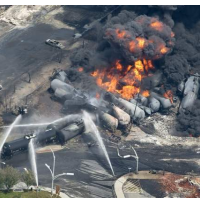State Confirms Huge Jump in Dangerous Oil-by-Rail Shipments but Details Are a Trade Secret
 Lac-Mégantic oil tanker explosion July 6, 2013 (photo: Paul Chiasson, Canadian Press/Associated Press)
Lac-Mégantic oil tanker explosion July 6, 2013 (photo: Paul Chiasson, Canadian Press/Associated Press)
California, the third-largest refiner of oil in the country, is making a historical shift away from receiving transport by vessel to much more dangerous railroad tank cars. But, for now, the public is not privy to information about how much oil is being shipped to the state, what sensitive locales it is passing through and when the volatile shipments are making an appearance.
They are trade secrets, according to rail companies, and a new state government report gives no indication that will be changing anytime soon.
“Oil by Rail Safety in California,” produced by a group of state agencies, acknowledges that imports by rail increased 506% in 2013 over the year before. That still only raised the percentage of total imports by rail to 1%. Oil by tanker is 70% and pipeline does the rest. But the report projects that if everything goes the way rail and oil companies hope, 25% of the imports will be via rail by 2016.
Few people are crazy about the idea of having oil tankers carrying their toxic products through sensitive waters or having pipelines traverse fragile ecosystems, but critics say transport by rail is far more dangerous. The industry contemplates five or six 80- to 100-car trains a day full of crude snaking their way across mountains, past lakes and through cities.
The report warns that the oil will roll past the Feather River, across the Donner Pass and through densely populated areas like Los Angeles. “A rail accident almost anywhere in California would place waterways and sensitive ecosystems at risk,” the report says.
“Population centers, schools, and hospitals are frequently located near rail lines in urban areas and in the Central Valley. A highly populated area is located near a major high hazard area for derailments in the San Bernardino-Riverside area.”
The danger is exacerbated by the special nature of the new cargo and the tank cars that carry it. Much of the crude-by-rail is coming, and will continue to come, from the Bakken fields of North Dakota and the future offers the oil sands of Alberta, Canada. The Bakken fields are new, made possible by revitalized extraction techniques like fracking and acidization. They allow drillers to tap oil otherwise not accessible, by blasting rock formations apart with pressurized water, toxic chemicals and other materials.
Oil from North Dakota is said to be considerably more flammable than conventional crude. And, according to Environment and Energy Daily, transportation experts warn that the aging train cars are susceptible to rupture and puncture in a derailment.
The report concurs: “Incidents involving crude oil from the Bakken shale formation have been particularly devastating—most notably, the tragic accident in July 2013 in Lac-Mégantic, Quebec, where 63 tank cars of crude oil exploded, killing 47 people.”
The report goes on to list eight other “major accidents” this year and last that include “track failures, inadequate rail car equipment, and human error (such as leaving cars unattended without proper braking systems).” Federal safety experts are “closely examining the potential unique risks posed by transporting oil from the Bakken shale formation.”
In the meantime, cities and the state are largely being left in the dark as to the specifics of transportation. The National Transportation Safety Board (NTSB) found “crude oil transported by rail sometimes has been incorrectly characterized and labeled, and not transported with the level of protection mandated for the degree of hazard posed, inadequacies in route planning to avoid population centers and environmentally sensitive areas, and a need for auditing rail carriers to ensure adequate response plans are in place.”
That routing and safety plan information is also not being shared with the public and the future prospects sound bleak. The last of the report’s 12 recommendations suggests that state agencies get timely and complete data so they can evaluate and regulate oil by rail. They don’t get that now. First responders in cities and counties get even less. And the public gets nothing.
But that might change if the rail companies look kindly upon the report’s Suggestion #5. Noting that “oil by rail activity has generated considerable interest and concern from communities in which rail facilities are located or rail lines pass through,” the report proposes, “The CPUC and OES should request that the railroads should provide better outreach programs and more information to communities, including interactive websites and open community forums, and updates on additional voluntary safety advancements.”
It doesn't suggest the state order them or otherwise compel them. It just asks them to do better. Please. Because everyone cares about safety.
–Ken Broder
To Learn More:
The Public Eye: Fight over Crude-Oil Transports Through California Intensifies (by Tony Bizjak, Sacramento Bee)
Oil by Rail Safety in California (Governor’s Office of Emergency Services)
Two Bay Area City Councils Oppose Rail Superhighway for Dangerous Crude (by Ken Broder, AllGov California)
- Top Stories
- Controversies
- Where is the Money Going?
- California and the Nation
- Appointments and Resignations
- Unusual News
- Latest News
- California Forbids U.S. Immigration Agents from Pretending to be Police
- California Lawmakers Urged to Strip “Self-Dealing” Tax Board of Its Duties
- Big Oil’s Grip on California
- Santa Cruz Police See Homeland Security Betrayal in Use of Gang Roundup as Cover for Immigration Raid
- Oil Companies Face Deadline to Stop Polluting California Groundwater





